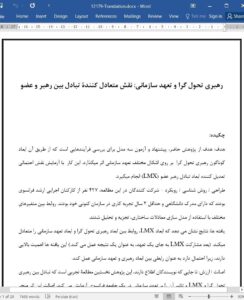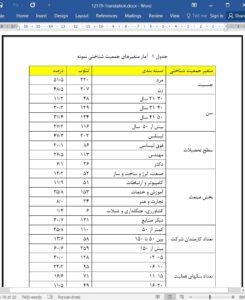Abstract:
Purpose– The aim of the present study is to propose and to test three models in order to examine the mechanisms through which dimensions of transformational leadership influence different forms of organizational commitment by testing the possible mediating role of leader-member-exchange (LMX) dimensions.
Design/methodology/approach– The participants in this study are represented by 427 senior executive French employees having a university degree and minimum 2 years of work experience in their current organization. The relationships between different variables were analyzed using structural equation modeling.
Findings– The results indicate that the dimensions of LMX mediated the relationships between the dimensions of transformational leadership and organizational commitment dimensions. – The contribution dimension of LMX acts as a consequence, rather than an antecedent of commitment. – These findings are important since they may serve as a bind between leadership dimensions and the kind of organizational commitment that each of these dimensions can generate in followers.
Originality/value– To the authors’ knowledge, this is the first empirical study that tests the interaction of transformational leadership and LMX on Organizational commitment in a French context. The originality of this work leads on investigating these three concepts as multidimensional constructs and focusing on the mediating role of LMX in the relationship between dimensions of transformational leadership and different forms of organizational commitment which can be considered as a novelty in the field of research in this area. As a result, this study addresses concerns about that lack of academic research on the mechanisms by which transformational leaders influence the organizational commitment of their followers.
INTRODUCTION
Leadership is one of the key functions of organizational management, since a strong leadership can help organizations in their permanent struggle to be increasingly competitive, as it helps to align people, timing and resources to achieve organizational goals (Avolio, 1999). Leadership can be defined as the relationship established between an individual (the leader) and a group (the followers) such as group behavior is directed or determined by the leader (Shastri et al., 2010). Leaders can use different styles to exert influence on followers. The dominant approach in leadership literature has been to consider two distinct styles of leadership: transformational and transactional (Bass and Avolio, 1993). While the main tool of transactional leadership to motivate employees is tangible rewards (money and status), transformational leaders use also intangible rewards (personal development, recognition, self-esteem enhancement). Extant research (Yammarino et al., 1993; Wang et al., 2011) has shown that transformational leadership styles are more effective than transactional to motivate employees and to enhance organizational performance.











